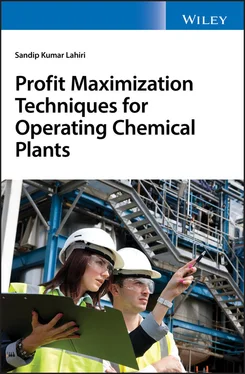3.1.7 Step 7: Develop a Real‐Time Fault Diagnosis System
Disruption of whole operations due to malfunctions of various process equipment is very common in chemical plants. In the worst case, due to malfunction of compressors, distillation columns, a process instrument, the electrics of a whole plant tripped and a large amount of money was lost. Today's chemical plants are so complicated and interrelated between various sections that once a plant trips, the whole process becomes destabilized and it takes 1 or 2 days or more to stabilize the process and continue on‐spec production. This not only reduces the profit due to a lower production rate but also represents a huge loss due to flaring/draining, production of off‐spec production, etc. Early detection of a fault or equipment malfunction can help to take corrective or preventive actions at their incipient stage and thus avoid the financial loss. Fault diagnosis of equipment or a process is an online real‐time system, which continuously monitors various equipment‐related data (say temperature, pressure, vibrations, etc.) and sends an early alert signal when a fault is detected. This early alert is triggered before the fault actually disrupts the process. This will help the concerned engineer to focus on the particular fault and take preventive action to avoid process disturbance. In most cases where a fault is detected at its incipient stage the operator will be able to avoid trips and reduce the financial loss associated with a plant trip. It is absolutely necessary nowadays to implement a fault detection system in running a plant to increase its on‐stream factor, i.e. running hours.
3.1.8 Step 8: Perform a Maximum Capacity Test Run
Capacity expansion is the single most important strategy used to increase profit. Capacity expansion means an increase in the plant throughput (measured by product flow in MT/h) over and above its name plate capacity. There are various design margins available in various process equipment. A maximum capacity test run is a process that systematically increases plant capacity and exploits these margins. It is possible to increase plant capacity by 5–10% without any major investment and simply utilizing the hidden margins available in installed equipment. The main idea behind a maximum capacity test run is to slowly push the plant capacity until it reaches major equipment or process limitation. This is a very important tool used to increase the plant profit by systematically running the plant at a higher capacity.
3.1.9 Step 9: Develop and Implement Real‐Time APC
PID control formed the backbone of a control system and is found in a large majority of CPIs. PID control has acted very efficiently as a base layer control over many decades. However, with the global increase in competition, process industries have been forced to reduce the production cost and need to maximize their profit by continuous operation in the most efficient and economical manner.
Most modern chemical processes are multivariable (i.e. multiple inputs influence the same output) and exhibit strong interaction among the variables (Lahiri, 2017b).
In a process plant, it is only seldom that one encounters a situation where there is a one‐to‐one correspondence between manipulated and controlled variables. Given the relations between various interacting variables, constraints, and economic objectives, a multi‐variable controller is able to choose from several comfortable combinations of variables to manipulate and drive a process to its optimum limit and at the same time achieve the stated economic objectives. By balancing the actions of several actuators that each affect several process variables, a multi‐variable controller tries to maximize the performance of the process at the lowest possible cost. In a distillation column, for example, there can be several tightly coupled temperatures, pressures, and flow rates that must all be coordinated to maximize the quality of the distilled product.
Advance process control (APC) is a method of predicting the behavior of a process based on its past behavior and on dynamic models of the process. Based on the predicted behavior, an optimal sequence of actions is calculated. The first step in this sequence is applied to the process. Every execution period a new scenario is predicted and corresponding actions calculated, based on updated information.
The real task of APC is to ensure that the operational and economic objectives of the plant are adhered to at all times. This is possible because the computer is infinitely patient, continuously observing the plant and prepared to make many, tiny steps to meet the goals (Lahiri, 2017b).
APC has established itself as a very efficient tool to optimize the process dynamically, minimize variations of key parameters, and push the plant to multiple constraints simultaneously and improve the profit margin on a real‐time basis.
3.1.10 Step 10: Develop a Data‐Driven Offline Process Model for Critical Process Equipment
If data is the new oil in a modern chemical industry, then the data‐driven modeling technique is a combustion engine. Industrial chemical processes are complex to understand and difficult to model. However, to increase profit and run the chemical processes at their optimum, availability of a reliable mathematical model is very crucial. Chemical engineering has not developed to accurately develop the phenomenological model of complex chemical processes like catalytic reactors, adsorption, etc. As the chemical industry has a huge amount of historical operating data available in its server, a data‐driven process modeling technique has emerged as a viable option. How to use various data‐driven modeling techniques to increase profit in plants is a key challenge. Data‐driven modeling is an important tool used to increase profit by modeling major process equipment and then optimizing various process parameters associated with it so that performance of the equipment is maximized. In this step, big ticket items like a reactor, major distillation columns, and major compressors are identified where developing a model and later optimizing it can have a big impact on plant profitability.
3.1.11 Step 11: Optimizing Process Operation with a Developed Model
Once a process model is developed for a major equipment, the next step is to optimize various process parameters so that efficiency or performance of that equipment is maximized. Due to cut‐throat competition in business, companies now want to reduce their operating costs by optimizing all their available resources, be it man, machine, money, or methodology. Optimization is an important tool that can be utilized to strike a proper balance so that profit can be maximized in the long run.
Since capital costs are already incurred for a running plant, optimization essentially boils down to minimization of operating costs for the operating plants. In running a chemical plant, there is a huge scope to optimize the operating parameters, like temperature, pressure, concentration, reflux ratio, etc., which give either higher profit through higher production or lower operating costs. There are many ways to optimize the operating conditions of reactors, distillation columns, absorbers, etc., to enhance their profitability.
Various recent stochastic optimization techniques, like genetic algorithm, differential evolution, particle swarm optimization, etc., have been used to optimize the developed data‐driven model.
3.1.12 Step 12: Modeling and Optimization of Industrial Reactors
A reactor is the only major equipment that can convert raw materials to a value‐added product. In chemical plants, the real value addition is done only in the reactor. Downstream separation units like distillation towers can be considered as cost centers because they consume energy to separate different products made in the reactor. All the downstream unit operations are for separation of the product and enrichment. Separation units consume energy and cost, whereas the reactor generates money by adding value to raw materials by converting them to a product. Hence, from a profit point of view, reactors are different from a downstream distillation column or other separation units.
Читать дальше












